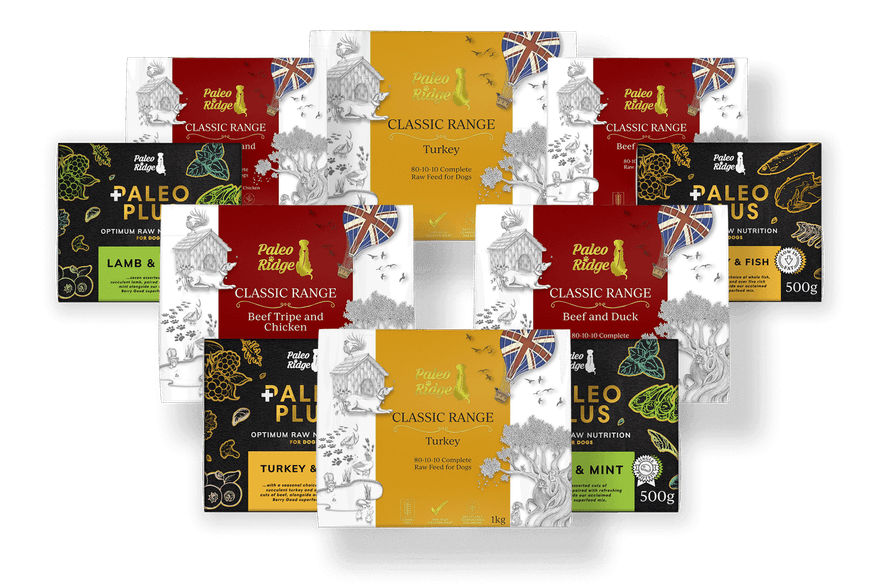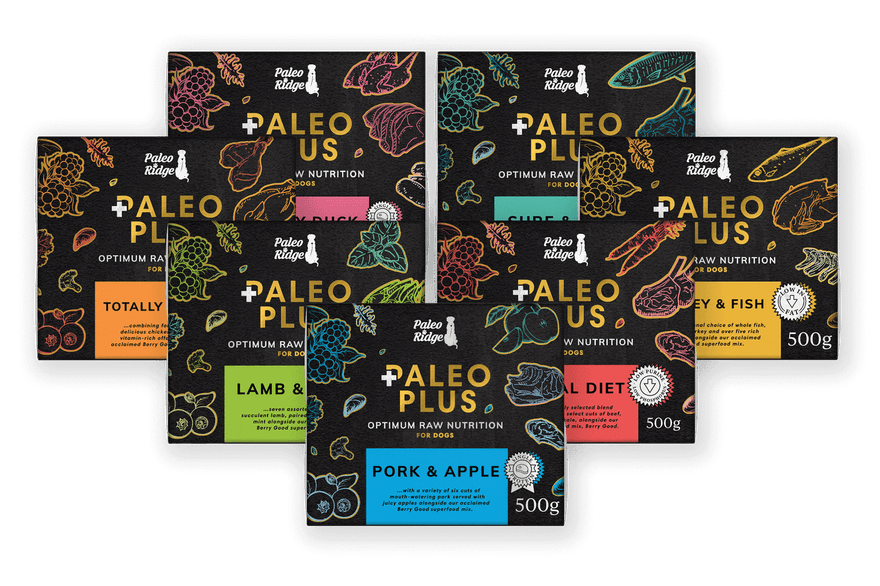BARF Diet - A Raw Dog Food Alternative
What is a BARF Diet?
Biologically Appropriate Raw Food (BARF) is a raw dog food diet comprised of muscle meat, bone & offal at the 80:10:10 ratio and supplemented with up to 20% fruit & vegetables.
The makeup of the BARF model includes:
- Raw Meat and Offal: The BARF model allows for feeding raw muscle and organ meats whether in the 80:10:10 format or as whole prey animals, such as chickens, which can be more representative of a dog’s ancestral diet.
- Raw Bones: BARF includes feeding raw bones to dogs as a significant component of their diet. These bones help promote dental health, provide essential minerals, and offer mental stimulation.
- Fruits and Vegetables: The BARF model includes the addition of a variety of fruits and vegetables to the dog’s diet to provide additional nutrients, fibre, and phytonutrients.
The BARF model aims to offer a wider range of nutrients by incorporating fruits and vegetables. Typically, a BARF diet is made up of a 20% mix of fruit and vegetables, in addition to the 80-10-10 ratio however, this may differ across brands and recipes.
Complete & Balanced BARF Dog Food
According to the FEDIAF nutritional guidelines, complete dog food is food that sufficiently meets the daily nutritional needs of a dog.
Complete dog food must contain the four essential nutrient groups dogs need to live a healthy life.
- Proteins: Proteins help with muscle development and many important body functions. It is an essential nutrient in a dog's diet as it produces energy and builds the solid structures of the body such as skin, muscles nails and bones. Great sources of protein include chicken, duck, turkey, fish, pork and beef.
- Fats: Healthy fats including omega-3 fatty acids are essential to regulate body temperature, promote a healthy nervous system and develop healthy skin and shiny coats. Oily fish, bone marrow and duck are healthy sources of fat.
- Vitamins: Vitamins A, D, E, B2, B7 & K are essential for growth and maintaining general good health. Sources of vitamins include fish, offal, carrots, hemp seed powder kale and berries.
- Minerals: There are two types of minerals, macrominerals, needed in large quantities and microminerals which the body needs in small quantities. Like vitamins, minerals play an essential role in maintaining proper metabolic functions in a healthy dog from transporting oxygen to building strong bones. Excellent sources of minerals include raw meaty bones, muscle meats and offal.
Although many believe dogs require carbohydrates as part of a complete and balanced meal, this is not true. As carnivores, dogs have evolved to extract energy from protein and fats. Feeding carbohydrates introduces a form of sugar in the form of glucose which if unchecked could result in obesity and other health issues. Read our article on Your Dog The Carnivore to learn more.
Feeding a BARF Diet
The Paleo Ridge range of complete and balanced BARF products, Essentials and Paleo Plus, are formulated to ensure your dogs get all the nutrients they need in convenient 500g packs. It is important to know what to feed, how much to feed and how often to ensure optimal health.
What to Feed Your Dog
The easiest way to ensure your dog is fed a healthy raw diet is to feed them a variety of proteins (muscle meats) as different proteins offer a varied concentration of nutrients. Therefore, feeding a variety of pre-made raw dog food products by Paleo Ridge is a great way to ensure your dog gets all the nutrients they need to thrive.
Nutritional Profile of Our Ingredients;
The following ingredients are great sources of the listed nutrients.
*Please note that this is not an exhaustive list.
- Beef: Iron, Selenium, Vitamins B2, B3, B6 and B12, Magnesium, Calcium and Copper
- Pork: B Vitamins, Zinc, Iron and Phosphorus
- Lamb: Iron, Vitamins B3 and B12, Selenium, and Phosphorus
- Venison: Zinc, Phosphorus, Iron, Selenium, B Vitamins and Vitamin E
- Rabbit: Sodium, Calcium, Phosphorus and Magnesium
- Kangaroo: B Vitamins, Zinc, Iron and Omega-3 and Omega-6 fatty acids
- Oily fish (mackerel, sardines & sprats): Vitamin D, B Vitamins and Selenium
- Chicken: Vitamin B3 and B12, Selenium, Zinc, Magnesium, Phosphorus and Biotin
- Turkey: Vitamin B6 and B12, Choline, Selenium, Magnesium and Phosphorus
- Duck: Iron, Selenium and Vitamins B3, B12 and Vitamin C
- Green Lipped Mussels: Omega-3, Vitamins C and E, Zinc and Copper
- Kale: Vitamins B, C and E, Potassium, Magnesium, Selenium and Antioxidants
- Blackberries: Vitamins A, B, C, E and K, Copper, Manganese, Fibre and Antioxidants
- Blueberries: Iron, Phosphorus, Calcium, Fibre, Manganese, Magnesium and Zinc
- Hemp Seed Powder: Iron, Zinc, Amino acids, Omega-6 and 3 and B Vitamins
- Broccoli: Fibre, Protein, Iron, Potassium, Calcium, Vitamins A, C, E, and K
- Seaweed: Vitamins A, B, E, D and K, Iodine and Amino acids
How Much to Feed Your Dog
It is recommended that when feeding an adult dog, you need to feed 2-3% of their ideal adult weight daily. If your dog's ideal adult weight is 20kg, for instance, you'll need to feed them 500-625g daily.
The fact that puppies are actively growing means that they need more food than adult dogs especially if they are large or giant breeds. As a result, the recommended amount for puppies is 5-6% of their ideal adult weight daily.
Like us, every dog is different so it is important to monitor their weight and increase or reduce their food as required. Working dogs and dogs with fast metabolisms may require more than the recommended amount.
If you're not sure of your dog's ideal adult weight, talk to your vet or a reputable breeder. Alternatively, the Kennel Club might offer some guidance.
Our Raw Dog Food Calculator is a great tool to help you figure out how much to feed.
How Often to Feed Your Dog
Once you've worked out how much to feed your dog daily, the next stage is to figure out when or how often to feed them. For most adult dogs, the feeding schedule can be flexible - simply divide the daily amount into as many meals as you want. Most owners feed 1-3 meals a day.
For puppies up to three months old, it is recommended that you feed them a maximum of four times a day to ensure they get all the nutrients they need to fuel their growth.
Raw Dog Food Calculator
Use our dog food calculator to work out the perfect amount to feed your pooch.
Switch To Raw Guide
Download your copy of our Switch to Raw Guide to get started on your raw feeding journey.
Raw Feeding Safely
When raw feeding, the most important thing to have in mind is good hygiene.


